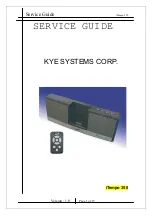
CONNECTING USB DEVICES
You can use the USB-C Power Delivery / Data port, USB-C port and USB 3.0 ports for connecting your
keyboard, mouse, external hard drive, printer and other devices or you can use it for connection of an USB
HUB by which you will gain some more free USB ports. In this case we recommend using a HUB with an
external power source. If the connected device is not charged or does not work, connect the original /
external USB-C power adaptor to the power connector of the parent notebook / Mac / smartphone / tablet
or USB-C Power Delivery port on the docking station.
Notes for using the USB-C port:
Fully compatible devices / systems (Alt Mode & Power Delivery)
USB-C is a new standard with a large diversity of uses, while the information on compatibility is complex.
Some USB-C devices / systems support Alt Mode video output, while other devices do not. Some can be
energized and charged from USB-C Power Delivery, while other devices do not. Devices / systems currently
supporting both Alt Mode and Power Delivery include for example MacBook Retina 12" 2015/2016,
Chromebook Pixel 2015 and Dell XPS 13" 9350 / 15" 9550.
Partially compatible devices (supporting either Alt Mode or Power Delivery, but not both)
Many current USB-C devices that support Alt Mode video output do not support charging from USB-C Power
Delivery. These devices still need their original power adaptors for charging. On the other hand, some USB-C
phones or tablets can be charged from Power Delivery, but most of them do not support Alt Mode video
output.
Non-compatible devices / systems
The docking station uses new functions introduced with USB 3.1 and as such the USB-C Power Delivery is not
backward compatible with USB 3.0 / 2.0 for charging of older devices. Further, the USB-A 3.0/2.0 (Male)
convertors to USB-C (Female) for connecting USB-C devices in USB-A 3.0 ports of the docking station are not
compatible either. Most current phones and tablets with the USB-C port do not support Alt Mode video
output and some do not support USB-C Power Delivery. Check the compatibility with this technology in the
device documentation or contact the device manufacturer. Lenovo Yoga 900 is not compatible with the i-tec
USB-C Travel Docking Station. No phones and tablets with the Android OS currently support Alt Mode video
output. Currently, ASMedia USB 3.1 controllers do not support Alt Mode video output.
CHARGING THROUGH POWER DELIVERY
Apple New MacBook, Windows 10 devices with a USB-C port or Chromebook Pixels etc.
The docking station offers USB-C Power Delivery / Data port, designed for energizing of the connected
“parent” device using the original power adapter and for charging of devices connected through the USB
ports. If you no need charging your devices through Power Delivery, you can use the port for data transfer.
CHARGING
The docking station supports charging of the connected USB mobile devices such as smart phones, e-book
readers, multimedia players, navigation devices, and tablets. Simply connect the device that you want to
charge using the original cable to the USB port of the docking station. If the device is not charged or does
not work, connect the original USB-C power adapter to the USB-C port of the docking station.
AUDIO
Audio output devices, for listening through HDMI, need to be set / verified here:
System Preferences-
Sound-Output –
select
HDMI Audio Device.
Setting the audio output device to both the earphones and the monitor simultaneously can be done in
Open-Applications-Utilities-Audio settings MIDI.app –
click on „
+
“ on the left at the bottom –
Create
device with multiple outputs
and select the desired outputs from the offered options on the
Device with
multiple outputs.
Note: The majority of problems with the docking station and the connected peripheral devices can be solved
by disconnecting the USB-C cable of the docking station from the USB-C port of the PC / Mac / smartphone
and reconnecting after approximately 10 s.





































